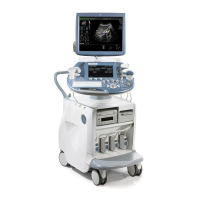Table 2-3 EMI prevention/abatement
EMI Rule Details
Be aware of Radio
Frequency sources.
Keep the system at least 5 meters (15 feet) away from other EMI sources. Special shielding may be
required to eliminate interference problems caused by high frequency, high powered radio or video
broadcast signals.
Ground the system. Poor grounding is the most likely reason a system will have noisy images. Check grounding of the
power cord and power outlet.
Assemble all screws, Radio
Frequency gaskets, covers
and cores.
After you finish repairing or updating the system, assemble all covers and tighten all screws. Any
cable with an external connection requires a magnet wrap at each end. Install all covers. Loose or
missing covers or Radio Frequency gaskets allow radio frequencies to interfere with the ultrasound
signals.
Replace broken Radio
Frequency gaskets.
If more than 20% or a pair of the fingers on an Radio Frequency gasket are broken, replace the
gasket. Do not turn ON the system until any loose metallic part is removed.
Do not place labels where
Radio Frequency gaskets
touch metal.
Never place a label where Radio Frequency gaskets meet the system. Otherwise, the gap created
will permit Radio Frequency leakage. In case a label has been found in such a position, move it to
another more suitable location.
Use GE- specified harnesses
and peripherals.
The interconnect cables are grounded and require ferrite beads and other shielding. Also, cable
length, material, and routing are all important; do not change from what is specified.
Take care with cellular
phones.
Cellular phones may transmit a 5 V/m signal; that could causes image artifacts.
Properly route peripheral
cables.
Do not allow cables to lie across the top of the card rack or hang out of the peripheral bays. Loop the
excess length for peripheral cables inside the peripheral bays. Attach the monitor cables to the
frame.
2.1.4 Environmental Requirements for Probes
Probes can be used in clinical environment.
Ensure that the probe face temperature does not exceed the normal operation temperature range.
Probes must be operated, stored, or transported within the parameters outlined below.
Operational Storage Transport
Temperature
+18º to +30º C
(+64.4°F to +86°F)
-10º to +50º C
(+14°F to +122°F)
-10º to +50º C
(+14°F to +122°F)
Humidity
30% to 75% RH non-
condensing
10% to 85% RH non-
condensing
10% to 85% RH non-
condensing
Pressure
700hPa (3000m) to
1060hPa
700hPa (3000m) to
1060hPa
700hPa (3000m) to
1060hPa
2.1.5 Time and Manpower Requirements
Site preparation takes time. Begin site preparation checks as soon as possible. If possible, six weeks before
delivery, to allow enough time to make any changes.
Warning
Have two people available to deliver and unpack the Voluson E-Series ultrasound system.
Attempts to move the system considerable distances (or on an incline) by one person alone, could result in
personal injury and/or damage to the system.
Site Preparation
2-4
Voluson E-Series Service Manual
5539550APB Revision 6

